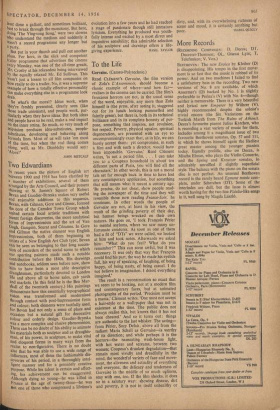Two Edwardians
IN recent years the picture of English art between 1900 and 1914 has been clarified by a number of exhibitions, several of them arranged by the Arts Council, and their present showing at St. James's Square of Robert Bevan and Gaudier-Brzeska makes very useful and enjoyable additions to this sequence. Bevan, with Gilman, Gore and Ginner, formed the core of the Camden Town Group which united certain local artistic traditions with recent foreign discoveries, the more analytical forms of impressionism and the art of Van Gogh, Gauguin, Seurat and Cezanne. In Gore and Gilman the native element was English Impressionism, both of them beginning as artists of a New English Art Club type; Bevan can be seen as belonging to that long succes- sion of recorders of the social scene to which our sporting painters made such a notable contribution before the 1840s. His drawings and notebooks, seldom seen before now, show him to have been a most able descriptive draughtsman, particularly devoted to London life and above all to horse sales, cab yards and markets. (In this field he is the Ben Mar- shall of the twentieth century.) His paintings demonstrate how this essentially topographical vision was transformed and modernised through contact with post-Impressionist form and colour; both elements were tactfully used, for Bevan had not only a sense of place and occasion but a natural gift for decorative colour and orderly design. Gaudier-Brfeska Was a more complex and elusive phenomenon. There can be no doubt of his ability to animate his materials both as sculptor and as draughts- man, of his power, in sculpture, to make vital and eloquent forms in many ways from the realist to non-figurative. There is no doubt also that he was able to use a wide range of
• Influences, most of them the fashionable dis- coveries of his period, in a thoroughly intel- ligent manner and for a genuinely creative purpose. While his talent is certain and affect- ing. his achievement can be exaggerated. Although dying so young—he was killed in France at the age of twenty-three—he was not one of those who compressed a lifetime's evolution into a few years and he had reached a stage of passionate though still immature lyricism. Everything he produced was youth- fully intense and excited by a most direct and inquisitive sensibility; this admirable selection of his sculpture and drawings offers a life-










































 Previous page
Previous page